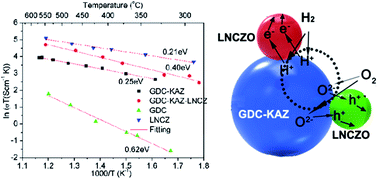Functional semiconductor–ionic composite GDC–KZnAl/LiNiCuZnOx for single-component fuel cell
Abstract
The research activities on single-component fuel cells (SCFCs) have opened new doors for keeping ahead with two major areas of focus: improvement of SCFC performances by contributing new materials, and scientific understanding of the SCFC nature and operation mode. The present work reports the exploitation of new material composed of the Gd doped ceria-KAlZn-oxide (GDC–KAZ) and the LiNiCuZn-oxide (LNCZ), combining ionic and semiconducting properties for SCFCs. A new method is first used through an internal electron–hole redox cycle resulting in no net electrons to avoid ceria electronic conduction problems thus to develop an excellent GDC–KAZ electrolyte. Its ionic conductivity, 0.08 S cm−1 at 600 °C, is ten times higher than that of GDC. The SCFC using the GDC–KAZ–LNCZ materials exhibits a remarkable electrochemical performance of 628 mW cm−2 at 580 °C, significantly higher than that of conventional three-component (anode/electrolyte/cathode) fuel cells. The results bring about a new cost-effective and robust system with significant scientific and economic consequences for the fuel cell field.


 Please wait while we load your content...
Please wait while we load your content...